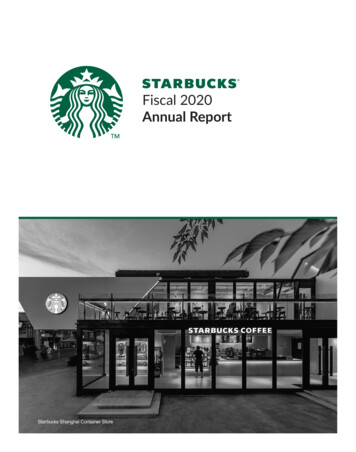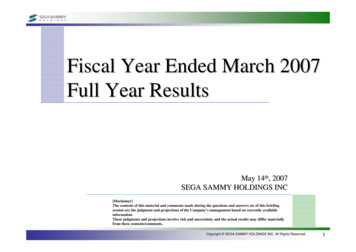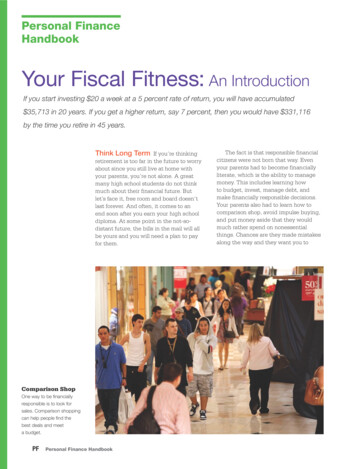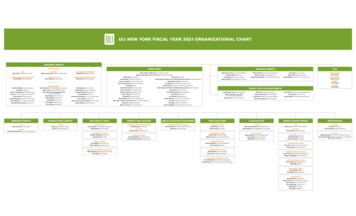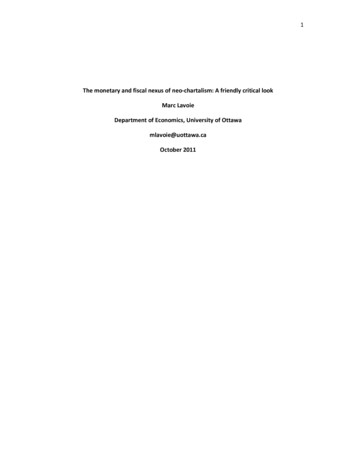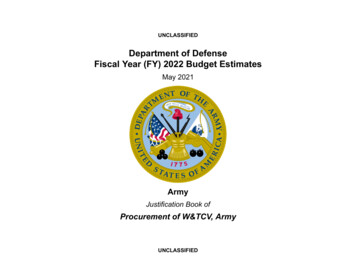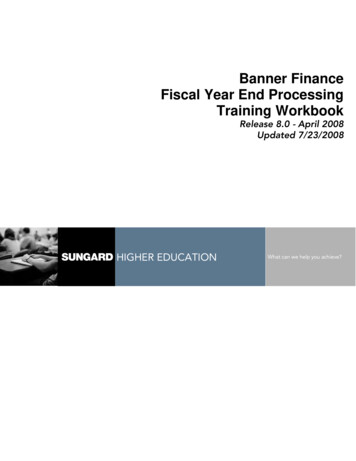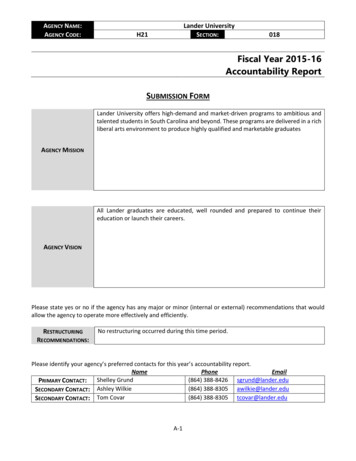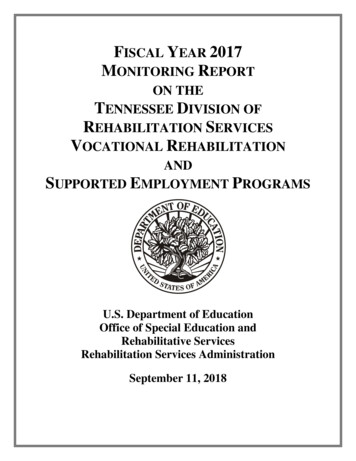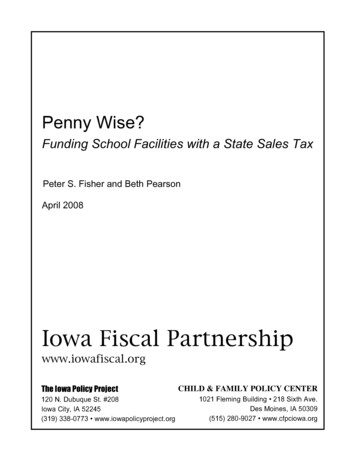
Transcription
Penny Wise?Funding School Facilities with a State Sales TaxPeter S. Fisher and Beth PearsonApril 2008Iowa Fiscal Partnershipwww.iowafiscal.orgThe Iowa Policy ProjectCHILD & FAMILY POLICY CENTER
AcknowledgmentsWe gratefully acknowledge the assistance of Shawn Snyder at the Legislative Services Agency. We arealso particularly grateful for the support of the Center on Budget and Policy Priorities, the StonemanFamily Foundation and the Annie E. Casey Foundation.AuthorsPeter S. Fisher is research director at the Iowa Policy Project. He is a Professor in the GraduateProgram in Urban and Regional Planning at the University of Iowa. A national expert on public finance,his reports are regularly published in State Tax Notes and refereed journals.Beth Pearson is a research associate at the Iowa Policy Project, where she analyzes economic and fiscaltrends in the state of Iowa. She received her master’s degree in Development Studies from theUniversity of Oxford in 2007.Iowa Fiscal PartnershipThe Iowa Fiscal Partnership is a joint initiative of the Iowa Policy Project and the Child & Family PolicyCenter, two nonprofit, nonpartisan Iowa-based organizations that cooperate in analysis of tax policyand budget issues facing Iowans. IFP reports are available at http://www.iowafiscal.org.The Iowa Fiscal Partnership is part of the State Fiscal Analysis Initiative, a network of state-levelorganizations and the Center on Budget and Policy Priorities to promote sound fiscal policy analysis.IFP work is supported by the Annie E. Casey Foundation and the Stoneman Family Foundation.1
Iowa Fiscal PartnershipApril 2008Penny Wise?Funding School Facilities With a State Sales TaxBy Peter Fisher and Beth PearsonIntroductionProposed legislation that would convert existing School Infrastructure Local Option (SILO) 1cent sales taxes in each of Iowa’s 99 counties into a 1-cent state sales tax raises questions ofhow this change would affect low-income Iowans and the overall health of the Iowa tax system.The proposal increases funding for school district infrastructure needs by removing a currentper-pupil cap on the distribution of pooled funding, as well as by collecting taxes on out-ofstate purchases and the sale of motor vehicles, neither of which are currently subject to theSILO tax. According to an analysis by the Legislative Services Agency, a switch to a statewidesales tax would generate 400.3 million in FY 2009 for school infrastructure funding, which is 28 million more than the current SILO system would generate. A 1-cent increase in the motorvehicle use tax — proposed by some for this legislation — would generate an additional 53million for road uses.The sales tax has a disproportionate impact on low-income Iowans, who pay a greaterpercentage of their income in sales tax than do those in upper-income brackets. The proposedlaw would institutionalize the shift from property taxes to sales taxes as a way of fundingschool infrastructure, rather than changing to a fairer system of financing, such as anexpansion of the school income tax. However, the switch to a state sales tax also would havepositive consequences. It would repeal SILO taxes currently paid on utility bills by thoseresidents who are not already paying a local franchise fee (about half of Iowans). Because lowincome Iowans spend a greater percentage of their income on utilities than on motor vehicles,this change would improve the fairness of Iowa’s tax system. And by enabling the greatestincreases in per-pupil funding for districts with higher proportions of students in poverty,switching to a statewide sales tax improves educational opportunities and enhances fairness.The bill also facilitates bonding for school buildings and helps ensure an adequate stream offunding. The funding flowing to a district, however, is the same amount per student regardlessof the district’s actual needs for facilities and equipment. While some districts may be indesperate need for new buildings, computers or energy-efficiency upgrades, others may havelittle in the way of basic or high-priority needs, in which case the revenue could be used forfacilities tangential to the district’s educational mission, or simply for property tax relief.Building a SILOIn 1998, the Legislature granted counties the authority to impose a voter-approved local salestax of up to 1 cent per dollar for school infrastructure. Local option taxes are collected2
countywide and distributed to all school districts in the county in proportion to the number ofpupils in each district. Localities in Iowa also have the authority to impose a limited number ofother local option taxes, including a Local Option Sales Tax (LOST), approved in 1985, thatgave cities and the unincorporated portion of counties the ability to levy a 1-cent sales tax. TheLocal Hotel and Motel Tax, authorized in 1978, allows cities and counties to impose a tax of upto 7 percent on the renting of hotel and motel rooms.Woodbury County was the first county in Iowa to approve a SILO tax, in October 1998. Growthin the number of counties with a SILO tax was modest from 1998 until 2003, in part becausemany rural counties had a limited sales tax base. Districts on the fringes of metropolitancounties were particularly disadvantaged by the SILO tax system, since their residents in manycases found themselves paying an additional penny sales tax when shopping in the adjoiningcounty, with the revenue going to support that county’s school systems. Disparities in SILOrevenue between sales-tax rich and sales-tax poor counties were large.In response to this problem, the Legislature amended the 1998 legislation in 2003 to, amongother things, create the Secure an Advanced Vision for Education (SAVE) fund, which collectsand distributes SILO revenues so that every district adopting the tax would receive a per pupilamount, currently capped at 575. To equalize sales tax revenue across districts, thelegislation also provided that the state will annually contribute 10 million to the SAVE fundthrough 2014. The legislation further required that any district renewing a SILO tax in the futurewould have to contribute any excess SILO revenue above 575 per pupil to the SAVE fund.Districts generating less than 575 per pupil would receive supplemental revenue from theSAVE fund.1 Districts that already had a SILO tax approved and were receiving over 575 perpupil would continue to receive all of the revenue generated in that county until the 10-yearauthorization expired.2The number of counties adopting SILO increased rapidly after 2003, and when Johnson andLinn counties approved SILO in February 2007 they became the last of Iowa’s 99 counties tohave adopted the measure.3 Original SILO legislation included a 10-year sunset provision forthe local option sales tax, and further amendments in 2004 provided for an extension of thissunset. Some counties have approved a 10-year extension of SILO, but almost three-quartersof counties will have it expire by the end of FY 2014. The 2003 legislation also included aprovision to repeal the SILO sales taxes everywhere as of December 31, 2022.Proposals for a Statewide School Infrastructure Sales TaxA proposal now under consideration by the Legislature would convert the local option SILOsales tax into a longer-term, statewide 1-cent sales tax.4 This “sixth penny” of the state salestax would go directly into the SAVE fund to be distributed to school districts on the basis of a1Some school districts currently receive less than 575 per pupil cap since local option sales tax revenue has notyet generated enough revenue to fund each school district at the cap level. However, the Legislative ServicesAgency expects this cap to be reached for all school districts by FY 2009.2A special provision for Johnson and Linn Counties, the only counties without the SILO who would generate morethan 575 per pupil if they adopted the tax, allowed districts in those counties to retain all SILO revenuegenerated for the first five years, as an inducement to adopt the tax. Both counties subsequently did so.3For an illustration of SILO growth, FY 1998 to FY 2008, see Iowa Legislative Services Agency (2007) SchoolInfrastructure Local Option Sales Tax. December 19, 2007. Available w/2008/IRSLS002.PDF.4House File 2663.3
revised per pupil distribution formula. Districts currently receiving more than the statewide perpupil amount because they had approved SILO prior to the creation of the SAVE fund in 2003in would continue to receive all of the revenue from the state penny generated in their countyuntil the expiration date of the original SILO authorization, or until the end of the five-yeargrace period in Linn and Johnson counties.At the state level, the sales tax on goods purchased in Iowa and the use tax on motor vehicles,as well as on goods purchased elsewhere but used in Iowa (primarily goods purchased bybusinesses), go hand in hand. An increase of 1 cent in the sales tax would be accompanied bya 1-cent increase in the use tax. For local option sales taxes, however, there is noaccompanying use tax. The shift to a statewide school infrastructure tax would therefore applythe “school penny” for the first time to car sales and out-of-state purchases. Revenue collectedfrom taxing out-of-state purchases would be directed to lowering property taxes in districts withthe highest additional levies, while the revenue from car sales would go to the road-use taxfund. In addition, some residential gas and electric utility bills are taxed by the existing SILOtaxes but were exempted from state sales taxes by legislation passed in 2001. The shift to astatewide school tax would eliminate the 1-cent tax on utilities that exists for some customers.The Legislative Services Agency estimates that this change would eliminate approximately 12million in sales taxes currently being paid by some residential utility customers.5There is little question that increasing the adequacy and sustainability of funding for schoolinfrastructure in Iowa is an important goal of state tax policy. The first 87.5 percent of adistrict’s per pupil cost (the “foundation level”) is funded through a combination of state aid andlocal property taxes. Every district must adopt the “uniform levy,” which is a local property taxof 5.40 per 1,000 of assessed valuation; state aid then makes up the gap between therevenue from the uniform levy and the 87.5 percent foundation level. In order to meet theremaining 12.5 percent of total cost, local districts must levy an additional property tax. The taxrate required to generate sufficient funds to meet this level varies from district to district,depending on the amount and value of available taxable property. According to the IowaAssociation of School Boards (IASB), the additional levy rate for fiscal year (FY) 2009 rangesfrom a low of 1.00 per 1,000 in the Okoboji school district to a high of 6.57 per 1,000 inthe Carlisle school district. The statewide average additional levy rate is 3.30 per 1,000 ofassessed valuation. Figure 1 below illustrates the range of additional levy rates across schooldistricts in Iowa.5Iowa Legislative Services Agency (2007) School Infrastructure Local Option Sales Tax, p. 7.4
Figure 1. FY 2009 Additional Levy Rates in Iowa School Districts Vary Widely7.006.00Dollars per 1,000 of assessed valuation5.004.003.002.001.000.00Converting the current system of local option sales taxes into a permanent, statewide pennydedicated to school infrastructure would help make this funding more sustainable and wouldincrease the amount of funding available for districts’ infrastructure needs. SILO funds can beused for activities for which a school district is authorized to contract indebtedness and issuegeneral obligation bonds under Iowa Code 296.1. This includes a broad range ofinfrastructure-related costs such as purchasing, repairing, improving or remodeling a schoolbuilding, gymnasium or bus garage. It can also mean furnishing a school building by installingnew equipment.In addition to the SILO tax, school infrastructure needs can be met either through the adoptionof another property tax (the Physical Plant and Equipment Levy) or by issuing bonds to berepaid from the debt service property tax levy. Because bonds require the approval of asupermajority (60 percent) of voters, they have not always proven to be a reliable source ofrevenue for districts with infrastructure needs. Since 1998, 56 percent of the 31 school bondissues presented to local voters across Iowa have been approved; if only a simple majority hadbeen required for passage, that approval rate would have increased to 77 percent.6 In otherwords, a minority of the voters in a school district was able to defeat the wishes of the majorityin over one out of five school bond referenda during the past 10 years.Before issuing bonds to be repaid from the school sales tax, a district revenue purposestatement, or infrastructure plans, must be approved by the voters. However, these statements6Legislative Services Agency (2007) Legislative Guide to Basic Education Finance, Available dfin.pdf, p. 26-7.5
require voter approval by a simple majority rather than a supermajority, which makes it easierfor districts to fund infrastructure than if they were required to issue a bond backed by propertytaxes. Furthermore, a statewide penny increases school districts’ ability to leverage bond fundsby allowing them to rely on a permanent funding stream. Under the current system, schooldistricts receiving supplemental funding from the SAVE fund because their SILO tax generatesless than the 575 per pupil level are only allowed to bond against the portion of their per pupilfunding that they generate from the local option tax itself. This is a consequence of thepotentially unsustainable nature of SAVE funding, which relies on the participation of individualcounties that must locally approve extensions of the sales tax, as well as on a temporaryannual state appropriation of 10 million per year through FY 2014.For example, although Warren County receives 536 per pupil in SILO revenue through theSAVE fund, it is only allowed to bond against the 356 per pupil that it generates locally.Humboldt County, on the other hand, can bond against 575 per pupil since it generates 621per pupil in SILO revenue (but, because it implemented SILO in 2005, must pay its excessrevenue into the SAVE fund). Districts in counties that approved SILO before the creation ofthe SAVE fund and can keep their excess revenue can currently bond against even higheramounts; Cerro Gordo County, for instance, approved SILO in 2003 and can bond against the 1,097 that it generates locally and retains.Converting SILO to a permanent statewide tax would affect school district bonding capacity intwo ways. First, it would increase equity in that all school districts would rely on the same levelof per pupil sales tax revenue — estimated at 774 for FY 2009 — or issuing bonds. Second,when school districts bond against locally generated sales tax revenue in the current system,they cannot actually bond against the entire amount of this revenue since local sales taxrevenue fluctuates from year to year. As a result, bond issuers only allow districts to bondagainst a lower level of their projected sales tax revenue and may charge higher interest rates.Moving to a statewide sales tax would likely allow school districts to bond closer to their totalper student amount and take advantage of lower interest rates because the revenue is moresustainable, stable, and predictable.The amount of funding available to meet districts’ infrastructure needs would increase with thetransition to a 1-cent statewide sales tax because this transition would also involve a switch tothe use of a five-year rolling average to calculate the per pupil infrastructure funding level.Under existing SILO legislation, per pupil funding amounts are statutorily capped at 575, eventhough revenue is soon predicted to be flowing into the SAVE fund in excess of this level. TheLegislative Services Agency estimates that, were a rolling average methodology used, perpupil funding for FY 2009 would be 774.Sustainability of infrastructure funding is a key concern because of the sunset provisions in thecurrent SILO law. These provisions also have consequences for the equity of funding acrossthe state. The SAVE fund that was created in 2003 to collect and distribute SILO revenue on aper-pupil formula increases equity by using sales tax revenue from districts with a large salestax base to subsidize infrastructure costs in districts with small sales tax bases. However,equity can be assured only if all Iowa counties continue to participate in the system bymaintaining a local option sales tax. Consider a school district that approved a SILO tax before2003 and is generating sales tax revenue well above 575. Because the county approvedSILO before the creation of the SAVE fund, it is allowed to keep its excess revenue withoutcontributing to SAVE until the 10-year expiration date of its original SILO. Suppose when the6
original SILO expires, voters do not approve an extension because it no longer seems likesuch a good deal — with the extension, their ability to export part of school taxes to shoppersfrom surrounding counties will have been eliminated. When this county drops out of thesystem, it will no longer pay into the SAVE fund.For instance, Johnson and Linn counties, both with large regional shopping centers, willcontribute substantial amounts to SAVE for the second five years of their SILO taxes, but theircontributions to SAVE would cease if voters failed to approve an extension, meaning that theSAVE fund would shrink. Each school district would subsequently receive a lower per pupilSAVE disbursement, which would especially disadvantage poorer school districts. ConvertingSILO into a statewide sales tax effectively makes the SAVE fund permanent and makes schoolinfrastructure funding more predictable and equitable. The sales-tax-rich counties cannot dropout. Instead, all pupils will continue to receive an equal share of all sales tax revenuegenerated statewide.Under the current proposal, in districts where a revenue purpose statement outlining theirinfrastructure funding plans fails to pass, funds from the statewide sales tax must be applied toproperty tax relief. The effect of this is to target property tax relief not at districts with littlevaluation per student and high tax rates, but simply at districts with less need or less votersupport for new facilities. Some of these districts will in fact be places with the least need forproperty tax relief: They have little need for new facilities because their high valuation perstudent, and resulting low tax rates, has made it easier to pass bond issues in the past.To address the problem of large disparities in additional levy rates, funding not used by adistrict that fails to pass a revenue purpose statement could, instead of being applied to taxrelief in that district, revert to the state fund and be applied to targeted property tax relief sothat districts with the highest additional levy rates benefit. Proposals to use the additional fundsgenerated by moving to a statewide sales tax (which is estimated to generate approximately 28 million more than the current SILO system) for targeted property tax relief alreadyrecognize the importance of making sure that property tax relief goes to the districts that needit most. The same principle could apply to unused statewide sales tax revenue.The current SILO system and the proposed statewide penny reserve sales tax revenue solelyfor infrastructure purposes. Another drawback to such an approach is that it creates a “use it orlose it” situation for local districts, which could result in spending on any kind of facility, neede
Penny Wise? Funding School Facilities With a State Sales Tax . the “school penny” for the first time to car sales and out-of-state purchases. Revenue collected . fund. In addition, some residential gas and electric utility bills are taxed by the existing SILO taxes but were exempted

